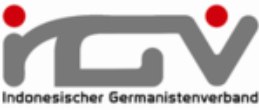APPLICATION OF WORDWALL APPLICATION IN LEARNING WECHSELPRÄPOSITION
Abstract
The difference in grammatical characteristics between Indonesian and German is one of the factors that cause students to have difficulty in learning Grammar. One example is in the use of prepositions. In German, prepositions are followed by several cases, namely Präposition mit Akkusativ, Präposition mit Dativ, Präposition mit Genitiv, and Wechselpräposition, while in Indonesian it is different. To overcome this problem, a study in the use of the Wordwall application in Wechselpräposition learning was conducted. The aims of this study were to determine: 1) students' mastery in Wechselpräpositionen before using the Wordwall application, 2) students' mastery in Wechselpräpositionen after using the Wordwall application, 3) the differences in students' mastery in Wechselpräpositionen before and after using the Wordwall application, and 4) the effectiveness of the Wordwall application in Wechselpräpositionen learning. The design used in this study is a Nonequivanlent Control Group Design, which is part of the quasi experimental. The population of this research were all students of class XII SMA Negeri 3 Palu who studied German and the samples of this research were class XII IPS 2 as the experimental class and class XII IPS 3 as the control class. The techniques for collecting data in this study were a test questions and questionnaires in the form of a Likert scale. The test was carried out twice as pretest and posttest. The test consists of 30 questions and the questionnaire of 15 statements. Based on the result of the data analysis, it can be seen that: 1) students' mastery in Wechselpräpositionen in the experimental class and control class before using the Wordwall application can be categorized as "failed", 2) students' mastery in Wechselpräpositionen in the experimental class after using the Wordwall application is included in the "good" category, while the control class is in the "sufficient" category, 3) there is a significant difference in students' mastery in Wechselpräpositionen before and after using the Wordwall application. This can be seen from the average pretest and posttest scores of the experimental class of 37.50 and 68.34, and 4) the Wordwall application is effectively applied in Wechselpräpositionen learning. This is evidenced by the result of the t-test that shows the value of Sig. = 0.002 < 0.005. In other words, there is a significant difference in mastery between the experimental class and the control class. In addition, the result of the data processing is supported by the results of the questionnaire containing positive student responses to the use of the Wordwall application in Wechselpräposition learning. Therefore, the Wordwall application can be used as an alternative learning media in Wechselpräposition learning.
Keywords: Learning media, Wordwall application, WechselpräpositionFull Text:
PDFReferences
Arikunto, S. (2018). Basics of educational evaluation (Second edition). Jakarta: Bumi Aksara.
Arsyad, A. (2017). Learning media (Revised edition). Jakarta: RajaGrafindo Persada.
Erdmenger, M. (1997). Medien im Fremdsprachenunterricht: Hardware, Software und Methodik. Seminar für Engl. und Franz. Sprache und deren Didaktik an der Techn. Univ. Braunschweig.
Hauschild, A. (2014). PONS Praxis-Grammatik Deutsch als Fremdsprache. PONS.
Petko, D., Kiel, E., Herzig, B., Maier, U., & Sandfuchs, U. (2019). Medien im Unterricht. Handbuch Unterrichten in allgemeinbildenden Schulen, 249-256.
Riduwan & Sunarto, H. (2017). Introduction to statistics. Bandung: Alfabeta.
Roigk, S. (2010). Medien im Unterricht. Universität Postdam: Postdam.
Rusman. (2018). Computer-based learning and learning. Bandung: Alfabeta.
Setiawan, A., Putria, A., & Suryani, N. (2020). Innovative learning media and its development. Bandung: PT Remaja Rosdakarya.
Sugiyono. (2019). Educational research methods. Bandung: Alfabeta.
Sugiyono. (2019). Statistics for research. Bandung: Alfabeta.
DOI: https://doi.org/10.17509/alm.v12i2.71849
Refbacks
- There are currently no refbacks.
Copyright (c) 2024 Ajeng Dianing Kartika, Nurul Iffah Agam Zuhdi

This work is licensed under a Creative Commons Attribution-ShareAlike 4.0 International License.
This journal provides immediate open access to its content on the principle that makes research freely available to the public and supports a greater global exchange of knowledge.
This work is licensed under a Creative Commons Attribution-ShareAlike 4.0 Internasional (CC BY-SA 4.0).

_(1)_(1)_(3)_.png)

